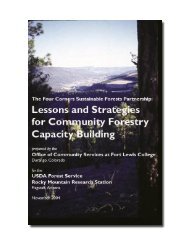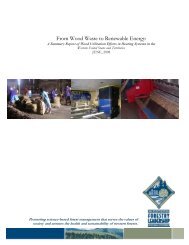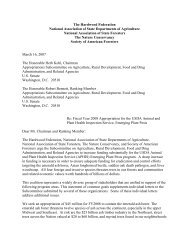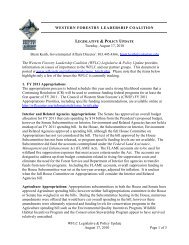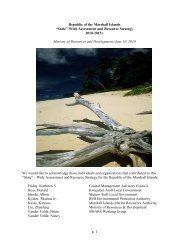Emission Controls for Small Wood-Fired Boilers - Western Forestry ...
Emission Controls for Small Wood-Fired Boilers - Western Forestry ...
Emission Controls for Small Wood-Fired Boilers - Western Forestry ...
You also want an ePaper? Increase the reach of your titles
YUMPU automatically turns print PDFs into web optimized ePapers that Google loves.
matter because they are <strong>for</strong>med by vapors in the combustion exhaust which cool and condense into<br />
particles. These vapors can also condense onto the surface of solid particles.<br />
Filterable and condensable particulate matter is grouped into three size classes. “Particulate matter”<br />
(PM) includes all sizes of filterable and condensable particles. The next smallest size class is PM10 or<br />
filterable and condensable particles equal to or less than ten micrometers in aerodynamic diameter.<br />
PM10 particles are also called “coarse particles.” PM2.5 is the smallest particle size class currently<br />
regulated. PM2.5 particles, also called “fine particles,” include all filterable and condensable particles less<br />
than or equal to 2.5 micrometers in aerodynamic diameter. For the purposes of this report, it was<br />
assumed all condensable particulate matter falls is less than 2.5 microns in diameter.<br />
Condensable particulate matter is reported separately from filterable PM2.5 because it is controlled<br />
differently. Some of the “condensables” will condense on filterable particles. Hence, anything controlling<br />
filterable particulate matter will inherently control some portion of the total condensables. Good<br />
combustion practices are the primary means <strong>for</strong> controlling condensables from small wood boilers<br />
without add‐on controls.<br />
Unless stated otherwise, the terms PM10 and PM2.5 will refer to filterable particulate matter only. This is<br />
because the methods used to measure the PM10 and PM2.5 emissions listed in this report measured<br />
filterable particulate matter only.<br />
RSG reviewed 24 recent stack emission tests to develop an understanding of existing emissions (see<br />
Appendix A <strong>for</strong> supporting stack test reports available <strong>for</strong> public consumption). All but one of these tests<br />
was completed after the 2001 RSG report. These stack tests were per<strong>for</strong>med in Idaho, Montana, New<br />
Hampshire, North Dakota, Rhode Island and Vermont. Twenty‐two of the tests were per<strong>for</strong>med on wood<br />
chip boilers and two tests were per<strong>for</strong>med on wood pellet boilers. All tests measured some <strong>for</strong>m of<br />
particulate matter emissions (filterable PM10, filterable PM2.5 and condensable PM). Some of the tests<br />
included other pollutants such as carbon monoxide (CO) and a selected number of Hazardous Air<br />
Pollutants (HAPs). Fuels burned included sawmill residue chips, bole chips, whole tree chips, bark chips,<br />
sawdust and municipal vegetative waste combined with ground pallets. Add‐on emission controls<br />
included cyclones, multicyclones, high efficiency multicyclones (HEMCs), core separators and baghouses.<br />
This study did not identify any stack emission data <strong>for</strong> ESPs on small wood‐fired boilers in the United<br />
States. However, according to the EPA “RACT‐BACT‐LAER Clearinghouse”, the lowest emission limit listed<br />
<strong>for</strong> PM and PM10 <strong>for</strong> large wood‐fired boilers controlled with ESPs is 0.02 lb/MMBtu (PM2.5 was not<br />
listed). 1 Given this limit is based on demonstrated technology, it is technically possible that small woodfired<br />
boilers could meet this limit. However, the economic analysis on which this limit is based is <strong>for</strong><br />
significantly larger systems (100 MMBtu/hour or greater), where the total cost per ton of pollutant<br />
removed is significantly lower. This is why the economic analysis per<strong>for</strong>med <strong>for</strong> this report was based on<br />
outlet emissions not exceeding 0.045 lb/MMBtu of all filterable particulate matter.<br />
It should also be noted that the larger facilities subject to the limit of 0.02 lb/MMBtu have the potential to<br />
emit more than an order magnitude more emissions and there<strong>for</strong>e must meet stringent emission limits in<br />
order to meet federal ambient air quality requirements.<br />
Table 1 summarizes the 24 particulate matter stack test results. <strong>Emission</strong>s are grouped into the three<br />
categories: filterable PM10, filterable PM2.5 and condensable PM. Table 2 through Table 4 summarize<br />
emissions by the following heat input categories:<br />
• Less than 30 MMBtu/hour and greater than 10 MMBtu/hour (based on seven stack tests).<br />
• Less than or equal to 10 MMBtu/hour (based on 18 stack tests).<br />
• Less than or equal to 5 MMBtu/hour (based on nine stack tests).<br />
A more detailed summary of all 24 tests is shown in Table 5.<br />
1<br />
This emission limit applies to a utility sized boiler whose heat input exceeds 100 MMBtu/hour.<br />
Resource Systems Group, Inc.<br />
<strong>Emission</strong> Control Technologies <strong>for</strong> <strong>Small</strong> <strong>Wood</strong>‐<strong>Fired</strong> <strong>Boilers</strong><br />
6 May 2010 Page 4



